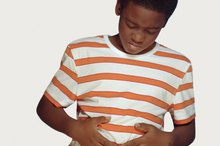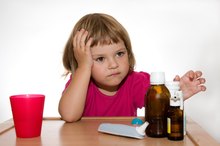Excess Abdominal Gas in Children
Excess abdominal gas in children, also called flatulence, is very common and is typically easy to cure. Gas is primarily made of odorless vapors, including carbon dioxide, nitrogen, oxygen, hydrogen and sometimes methane. Excess gas and gas that you can’t pass may cause intense abdominal pain. There are some measures that can help reduce gas and relieve pain in children.
If you are experiencing serious medical symptoms, seek emergency treatment immediately.
Causes
There are three main causes of abdominal gas in children: swallowed air, eating gas producing foods and certain diseases that interfere with sugar absorption. Children swallow excess air when chewing gum, sucking their thumb or if they have nasal allergies. Foods such as beans produce gas in the large bowl. Lactose intolerance also causes excessive abdominal gas in children. Additionally, intolerance to certain food sugars or diseases such as celiac disease and short bowel syndrome cause excess flatulence.
- There are three main causes of abdominal gas in children: swallowed air, eating gas producing foods and certain diseases that interfere with sugar absorption.
- Children swallow excess air when chewing gum, sucking their thumb or if they have nasal allergies.
Types
Stomach Pain After Eating in a Child
Learn More
Abdominal gas in children may be caused by an organic disorder, meaning it is caused by an identifiable problem, or a functional disorder, which has no identifiable cause. Organic disorders include constipation, heartburn, ulcers, muscle or bone pain. Functional disorders have no identifiable cause and include irritable bowel syndrome (IBS), abdominal migraine and functional dyspepsia.
- Abdominal gas in children may be caused by an organic disorder, meaning it is caused by an identifiable problem, or a functional disorder, which has no identifiable cause.
- Functional disorders have no identifiable cause and include irritable bowel syndrome (IBS), abdominal migraine and functional dyspepsia.
Symptoms
Symptoms of excess gas in children include abdominal cramping and pain, bloating, increased gas passage, constipation or diarrhea 2. Gas can become trapped in bends in the colon, under the liver and in the area under the spleen, causing pain and tenderness in these areas. These symptoms may keep your child awake at night. You should call your child’s doctor if the pain lasts more than a week, if your child is vomiting, losing weight, suffers from a fever, if the abdomen is stiff to the touch or if there is blood in your child’s vomit or stool.
- Symptoms of excess gas in children include abdominal cramping and pain, bloating, increased gas passage, constipation or diarrhea 2.
- Gas can become trapped in bends in the colon, under the liver and in the area under the spleen, causing pain and tenderness in these areas.
Treatments
A Bath With Baking Soda for Constipation in Children
Learn More
There are numerous ways to treat gas and bloating in children 2. The first and foremost is to avoid foods that may make the gas worse, such as milk or dairy products, whole grains, carbonated beverages and certain fruits or vegetables. Peppermint tea or simply chewing a leaf of peppermint may help reduce gas. Over-the-counter medications that contain simethicone, bismuth subsalicylate or activated charcoal may decrease gas. Medications such as Beano help to break down complex carbohydrates such as beans or other vegetables that cause gas.
- There are numerous ways to treat gas and bloating in children 2.
- The first and foremost is to avoid foods that may make the gas worse, such as milk or dairy products, whole grains, carbonated beverages and certain fruits or vegetables.
Suggestions
If your child has excess gas, there are a variety of ways to help them take care of it. Teach your child to release gas in a socially acceptable manner, such as leaving the room or going to the bathroom. Reduce your child’s intake of beans or carbonated beverages. Keep a diary of foods and beverages your child eats to pinpoint those that cause gas. Avoid food or beverages that contain lactose if your child is lactose intolerant. Deodorizing products such as underwear made from carbon fiber or charcoal lined cushions or pads may help reduce the smell of bothersome gas.
- If your child has excess gas, there are a variety of ways to help them take care of it.
- Teach your child to release gas in a socially acceptable manner, such as leaving the room or going to the bathroom.
Related Articles
References
Writer Bio
Christina McDonald-Legg has been writing about health, wellness and travel since 1999. Her articles have appeared in "Colures Magazine" (London), "The Sunday Times" (Dublin), "The Connacht Tribune" (Galway) and "The Seattle Post-Intelligencer," and been featured online by the U.K. Department of Health. McDonald-Legg holds a Master of Arts in journalism from the National University of Ireland.








